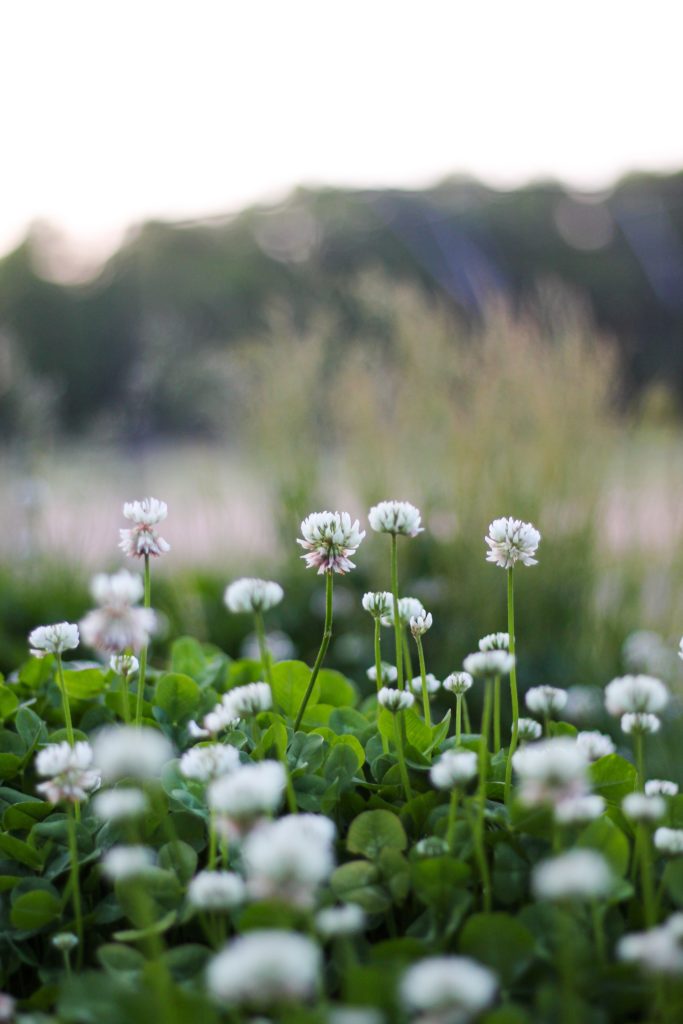Getting Started Growing and Grazing with Organics
4 December 2023Maximising Grassland Productivity
One of the most daunting prospects when moving to an organic system can be the loss of artificial nitrogen as a tool to manage grass production on the farm. This article shares the experience of one farm’s successful conversion to organic grassland.
For maximum grassland productivity when converting to an organic system, allow the time to ensure that soil pH levels are as close to optimal as possible (pH 6.3 – 6.5) and that P & K levels are optimal (Moderate status).
The nitrogen fixing properties of clover become essential to maintaining grassland productivity in an organic system. The Soil Association recommend having a clover content of 30-50% of the total sward, which would have the ability to fix between 180 and 250kg/ha N.
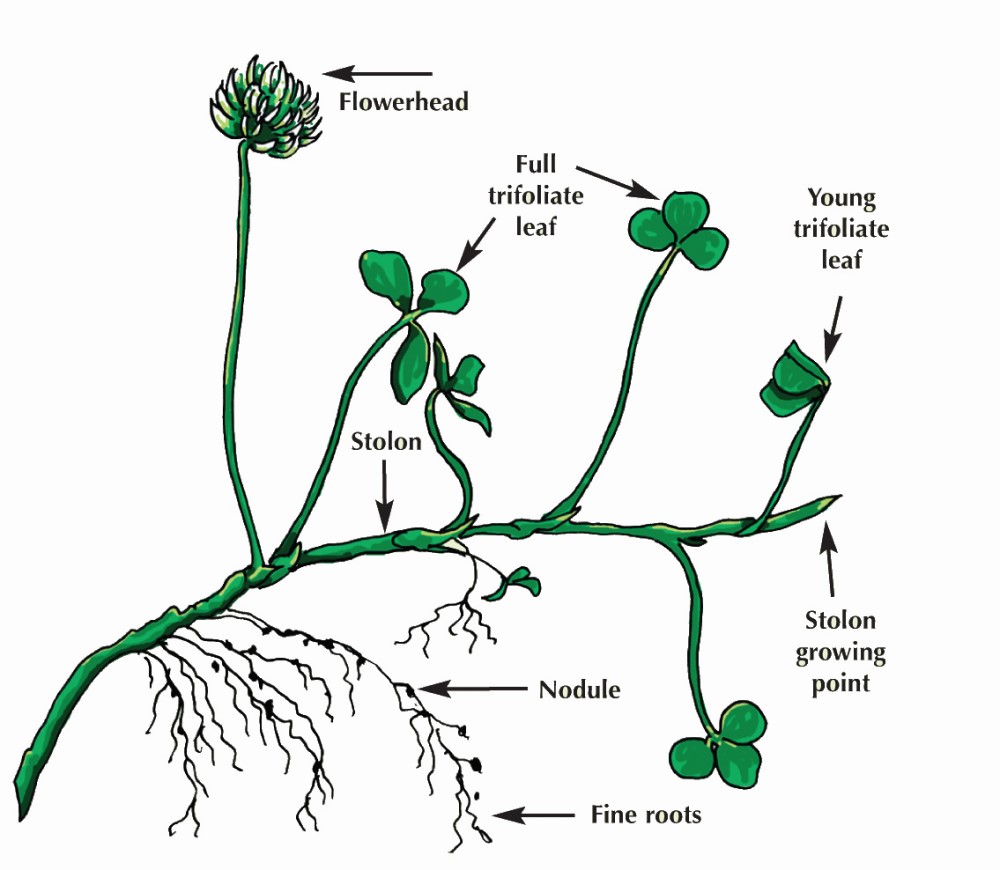
The picture opposite illustrates the nitrogen fixing nodules on the roots of the plant. When the nodules are actively fixing nitrogen in the summer months (see graph below), they will appear pink in colour. These should be easily visible if you dig up a clover plant, and the more nodules the greater ability that plant will have to fix nitrogen.
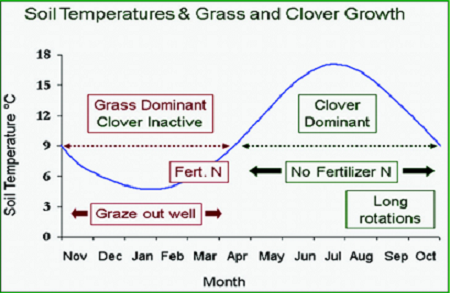
This graph shows the growth of grass and clover at varied soil temperatures. Clover plants are inactive when soil temperatures are below 9oC and when nitrogen fertiliser would be applied in a conventional system to boost spring grass growth. In an organic system, this nitrogen can be applied in limited quantities through slurry and FYM applications, but careful winter management of grass covers is also required to ensure that the sward is productive in the spring while the clover is still dormant.
Using Organic Manures
Making maximum use of the nutrients available in organic manures such as slurry and FYM is key to providing phosphate and potash for grass growth and maintaining soil status. Like most dairy farms, Outer Blair and Kildrochat Mains has a good supply of slurry collected during the winter housing period. An aeration system allows slurry which is stored in the slatted tank underneath the cubicle shed to be continually agitated which reduces ammonia emissions and has the potential to increase the nitrogen content of the slurry.
At Outer Blair and Kildrochat Mains all fields are spread with 3,000 gallons/acre of slurry in early February, with silage fields receiving a second application of approximately 2,000 gallons in early April. After first cut 2,000 gallons per acre is applied. Thereafter, silage fields are spread with parlour washings and dilute slurry. The table below shows the contribution that the slurry applications make to the overall crop requirement in a three cut silage system.
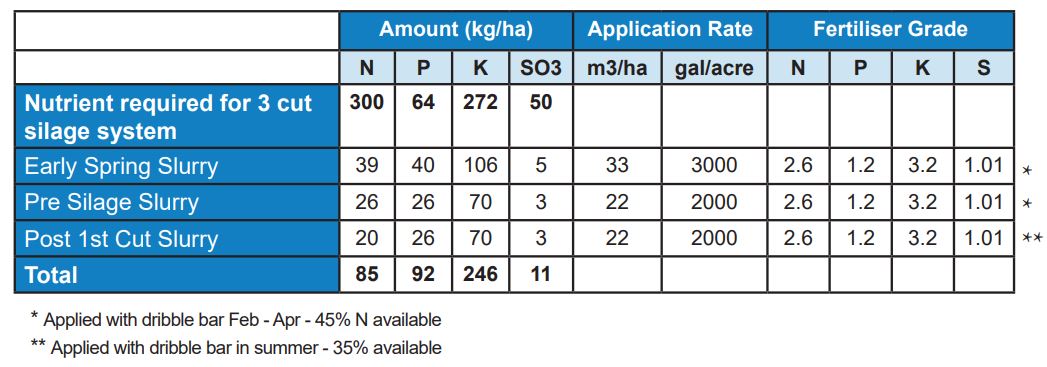
The figures assume that slurry is spread with a dribble bar and has used standard N, P & K figures from the Farm Management Handbook. Sampling slurry would allow more bespoke nutrient budgeting to take place.
Spreading dilute slurry/parlour washings with a dribble bar on grazing paddocks post grazing also boosts grass growth on the grazing platform.
Grazing Management
Grassland utilisation is maximised through paddock grazing of the dairy herd at Outer Blair and the purchase of additional land at Kildrochat will allow this to be developed further. Paddock grazing maximises grass growth by exploiting the growth cycle of the grass plant. At present the farm has 22-23 paddocks, which are grazed by the dairy herd. The aim is to have grazed all paddocks once before “Magic Day” (when grass growth exceeds demand usually around the 12th to 20th April on this farm) and three times before 1st of June.
Grass is measured weekly throughout the grazing season. In early May grass stocks are looked at and, depending on average farm covers, paddocks are taken out for silage. They are mowed and spread with dilute slurry to rejuvenate them before they are brought back into the rotation. Silage ground is brought back into the grazing rotation after first cut to facilitate this paddock rejuvenation programme. The addition of Kildrochat will allow paddock numbers to increase to around 30, which will increase cow grazing capacity and also give more flexibility during drought conditions which are being experienced more commonly.
Silage and Reseeding
Red clover is a common addition to organic silage leys as it not only fixes nitrogen for the grass crop, but also increases the protein levels of the silage crop, reducing the need to include expensive purchased protein in the dairy ration.
Outer Blair have tried red clover in their silage swards, but have found that it wasn’t persistent enough and now use a perennial ryegrass and white clover mix. Red Clover grows from a crown and will not withstand poaching or heavy grazing, it should also be cut at around 8cm to prevent damaging the crown.
Silage swards also tend to head quicker at Outer Blair compared to neighboring conventional dairy farms. This could be due to the grass varieties but is more likely to be due to stress that the grass plant is experiencing due to lack of nitrogen or drought. This has an adverse impact on silage quality, as the ME of grass reduces as grass heads and increases the fibre content of the plant.
A 5 to 7 year arable rotation is implemented at Outer Blair. Crop choices for reseeding are based on the weed burden of the field. A field with a low weed burden is sown with perennial ryegrass and white clover with a nurse crop of spring wheat/spring beans arable silage. The beans provide an additional nitrogen source, and the wheat helps to suppress weeds. The arable silage is whole cropped and the grass field returns to the grazing/silage platform. For fields with heavier weed burdens, Italian ryegrass is sown with the same arable nurse crop in the first year and then ploughed again in the second year and sown with perennial ryegrass/arable silage mix. The more vigorous Italian ryegrass sward provides better competition for weeds. FYM is applied to all fields before ploughing.
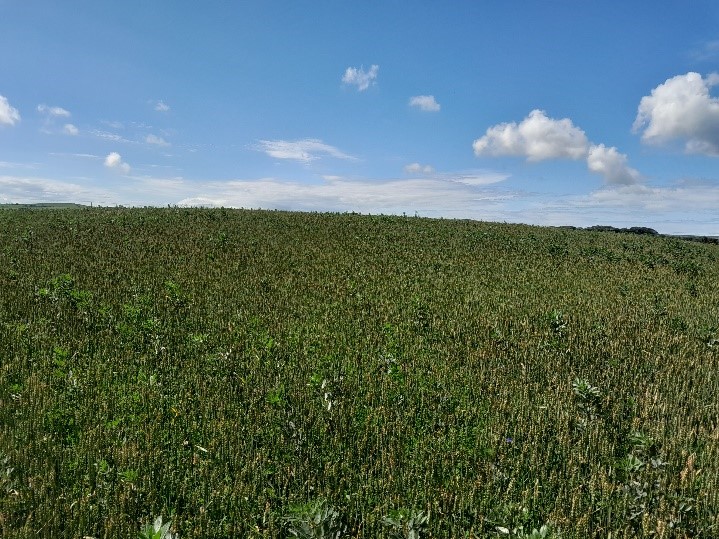
Seed Mixtures
When selecting grass mixtures, it is important to consider the purpose and duration for which you need that sward, as different species of grass have varying strengths and will be suited to particular situations. A wide range of organic certified seed mixtures is available. Visit OXS - Welcome to OrganicXseeds United Kingdom (Great Britain), the official UK GB database of organic seed availability for a comprehensive list of suppliers and seed availability.
Further Information
Sign up to the FAS newsletter
Receive updates on news, events and publications from Scotland’s Farm Advisory Service

